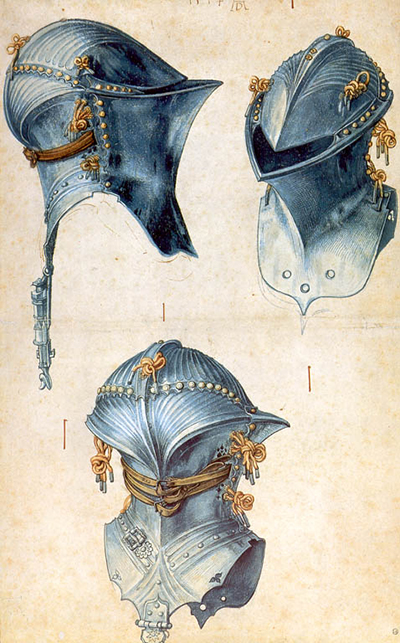German artist Albrecht Dürer is known primarily for his religious images. Yet this Renaissance painter created some fascinating images that had little to do with faith and religion. 'Three Studies of a Helmet' is one such image.
Dürer has provided us with a fascinating glimpse of another time. We view a helmet from three different angles. This is the helmet used with a suit of armour, a metal suit worn by warriors for combat or jousting (combat sport) purposes. The helmet's design is quite complicated, therefore the variety of angles gives the viewer a good view. Such helmets are not worn today, therefore this drawing provides a good opportunity to get a glimpse of this item. The style of the helmet in the drawing is known as a 'frogmouth helmet', or in the German language 'stechhelm'. This was worn during jousting tournaments rather than in combat. It was specially designed to protect the eyes. This project gives Dürer the opportunity to show off his drawing skills.
As we see the image of the helmet we can appreciate it from various angles. It's not an easy image to draw, hence the study from different sides. This work was created in 1503. Dürer is known for his paintings, for which he used watercolours. He is also known for his engravings or woodcuts. This particular work was executed with a pen. It is spare and concise, it flows with skill and grace. Dürer was not only an artist. He can also be considered a highly skilled craftsman. Like the other great Renaissance artists, he considered his art in a scientific and methodical way and paid particular attention to proportions and calculations. His body of work brings the 16th century alive for the audience of today. We get not only the scriptural insights but the insights of Dürer's time and place.
Anything scriptural that he painted was reproduced securely in his time and place. He often painted the background scenes in his city of residence, so what we usually see is a picture set in Biblical times that brings 16th century Germany vividly alive for us. Now most of us today would never have witnessed a jousting tournament. Apart from seeing a suit of armour in a museum, we would never have had the opportunity to see a knight's helmet at such close quarters, nor the opportunity to examine it. For this, we must thank Albrecht Dürer.




